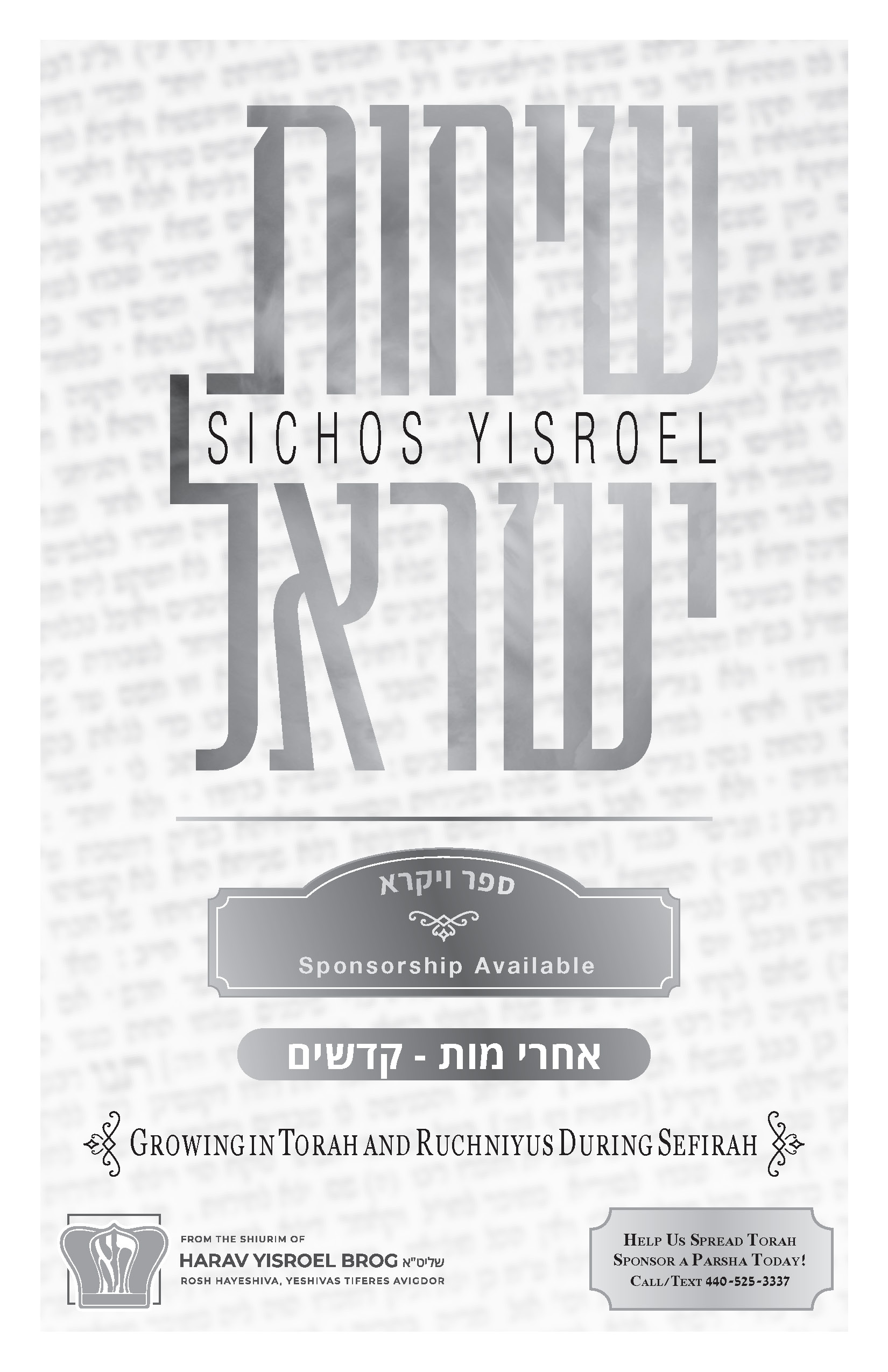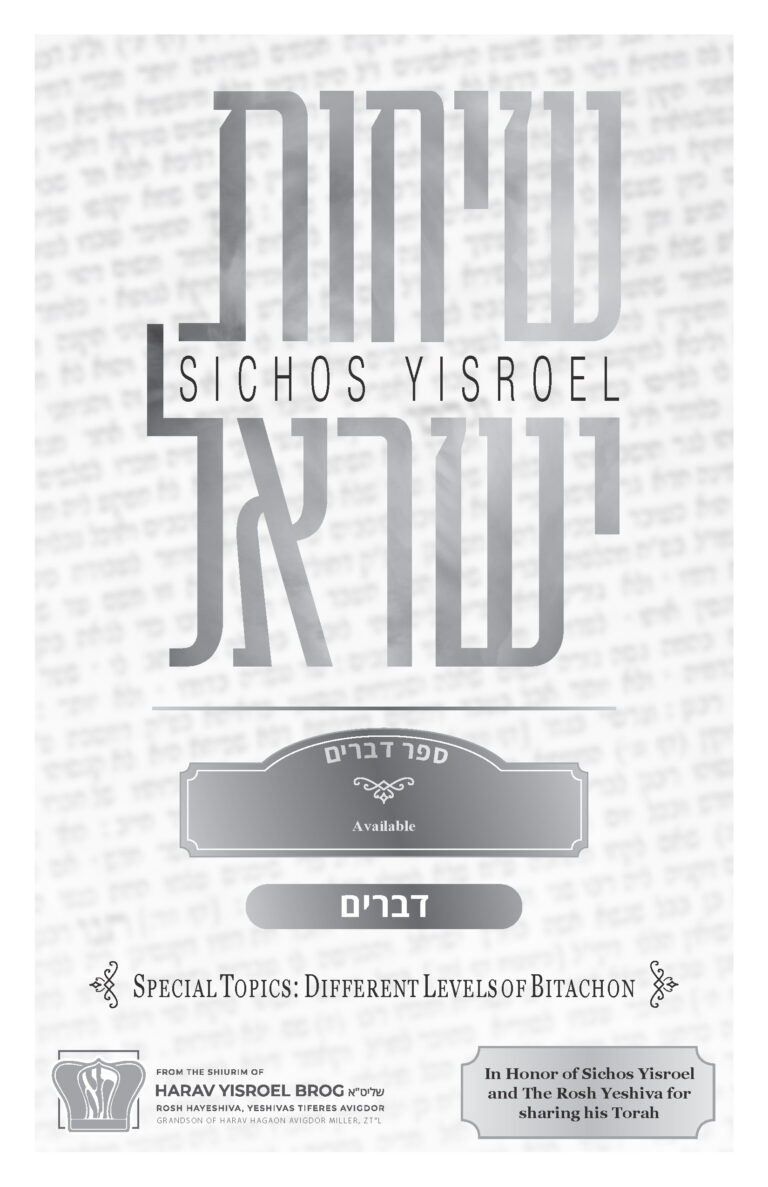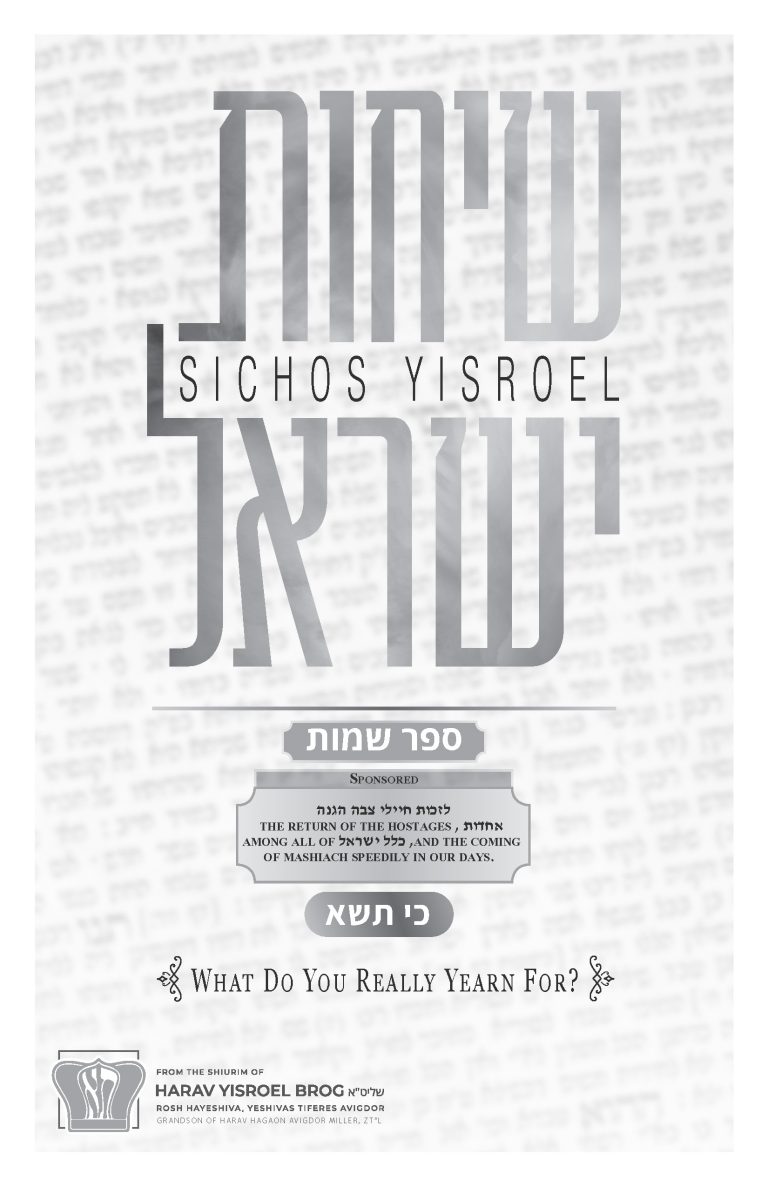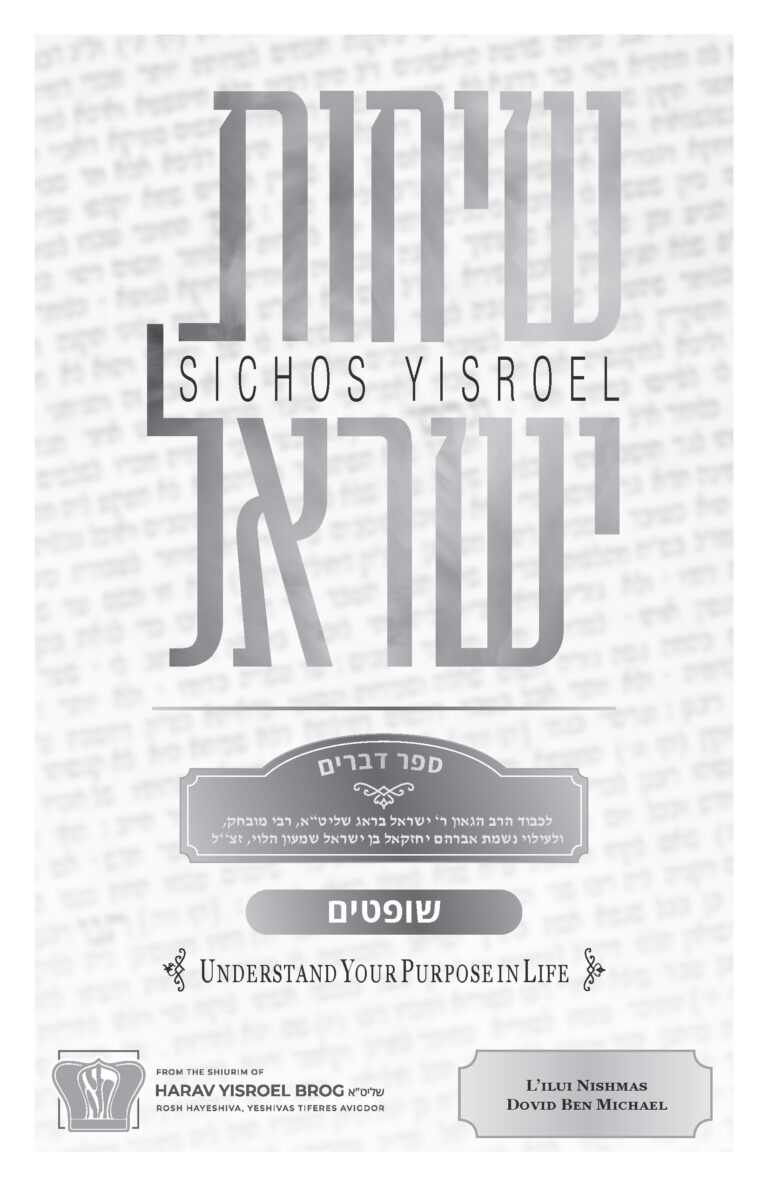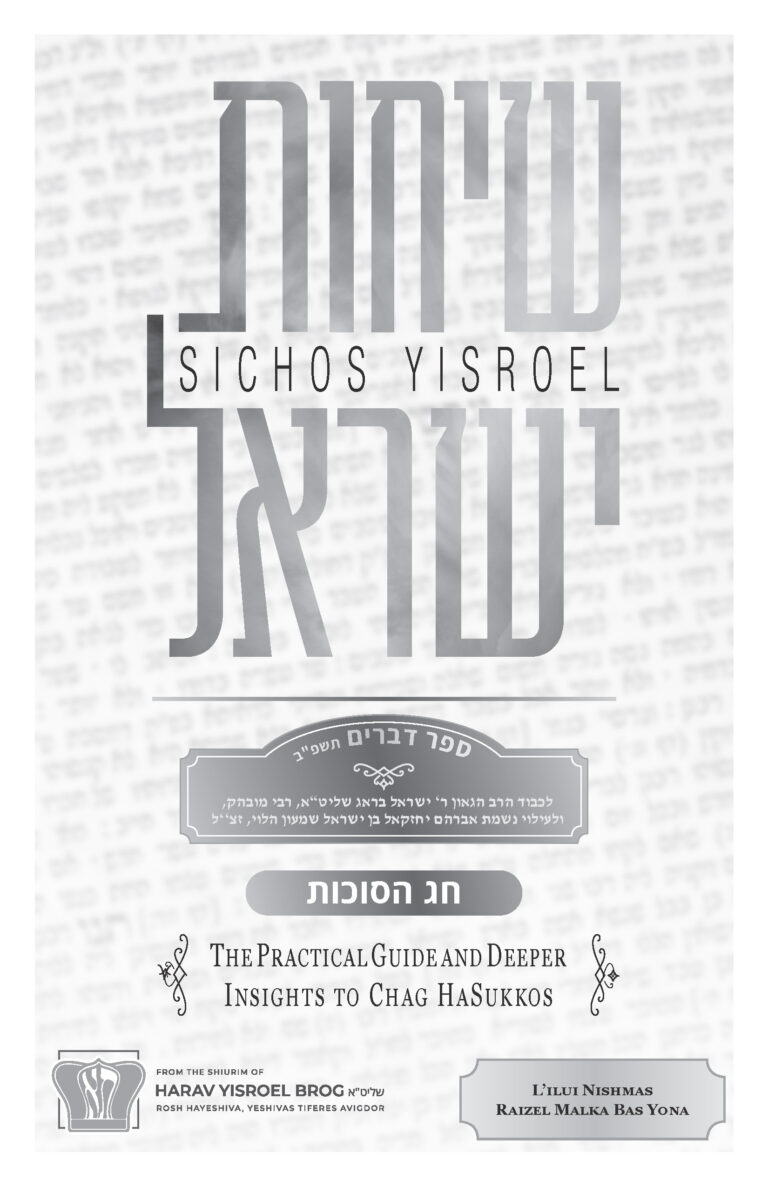Acharei Mos-Kedoshim 5783: Growing in Torah and Ruchniyus During Sefirah
Sponsored
לעילוי יצחק מאיר בן לב בלוי
Consider sponsoring a shiur
Visit YTATorah.org
Shiur presented in 5779
Strengthening Our Ruchniyus Muscles
We began to study the steps [based on pesukim in Mishlei 2:1-3] that are required during yemei sefiras haomer to bring out and connect us to our spiritual dimension. Not only is the dimension of ruchniyus of a person separate from the physical dimension, but it is also much more real and powerful. It endures lanetzach netzachim. The gashmiyusdike side does not endure at all. However the “muscles” that a person builds up in his spiritual dimension is what determines his true and real strength.
Have you ever seen a guy who looks like an oisgeklapt (beaten-up) hoishanah? You could think of some people like that right now. They look like they are barely hanging on by threads. Their physical color is not good. Their strength doesn’t look good. Their weight doesn’t look good. And your heart feels bad for them. But you should feel much worse when you see a person who is spiritually “deformed.” If the guy has got melted spiritual muscles, do you know what that looks like? “Come, let’s learn,” you tell him. “Oh, I can’t,” he tells you. “Why not?” you ask again. “I don’t have the strength to learn,” is his reply. That is what’s called melted spiritual muscles. “Come, let’s go daven.” “Oh, I can’t do that either.” That is a rachmanus. A person can’t sit by a gemara. A person who can’t get into a gemara. A person who lost his spiritual will. That is a tragedy of tragedies. That is a person who is shaku’ah, who has already sunk into the physical world and does not have any ruchniyusdike tzad to himself.
The days of sefirah, the yemei hamatmonim, are the days when you exercise and “stress,” your ruchniyus. This is the time to bulk up one’s ruchniyus. The heart of ruchniyus, where the lifeblood of a person who is connected to ruchniyus, are emunah and bitachon. These are functions of one’s lev. They are the foundations of the whole building of yahadus, of ruchniyus.
When Chazal say that רשעים בחייהם קרואים מתים – “The wicked, during their lifetimes are called dead” (Berachos 18b), you have to view that kipshuto (literally). When you look at a person who is not living a spiritual life, a person who is not a shomer Torah umitzvos, you are looking at literally a meis in a box. And if he is a barebones shomer Torah umitzvos, I view him as if he’s on his way to the hospital. He looks like a guy in a coma who has machines around him keeping him alive. That is what it looks like. It’s a most disheartening feeling. It’s a most depressing feeling.
When I see a bachur who is combing his hair and thinks that if he wears the cool pants, the silly socks, that now the guy feels like he’s mamash shtady guy – to me, it looks like a child with a doll who thinks he found shamayim, that he has his best friend. It’s pashut, he’s disconnected; it’s nituk!
These are the yamim – the 49 days Hashem gave us during the year to “bulk up” spiritually. There are ruchniyusdike legs. There are ruchniyusdike hands. There are ruchniyusdike backs. Each physical limb helps you for your spiritual dimension.
Six Steps to Spirituality (1-5)
We saw the steps that precede a person being zocheh to the matmonim (i.e., referring to the word וכמטמונים from the pasuk in Mishley 2:4, which also means “hidden gems”).[i]
Step number one is a decision to want to make a move to take [תִּקַּח] the words of Hashem (בְּנִי אִם תִּקַּח אֲמָרָי וּמִצְוֺתַי תִּצְפֹּן אִתָּךְ). I want to become a shtikel shoilet – I want to be in control over my ruchniyus. Then, step two, we said, whatever ruchniyus you have, you’ve got to have a sense of its value, so that you guard it and you review it [תִּצְפֹּן], and don’t let it become farshpilt. Number three, you have to learn how to listen [לְהַקְשִׁיב] intently to ruchniyus (לְהַקְשִׁיב לַחָכְמָה אָזְנֶךָ תַּטֶּה לִבְּךָ לַתְּבוּנָה). Listen very closely to what the passuk is saying, or to what the gemara is saying. Most people listen very shvach. Step number four was to delve into the tevunah [תַּטֶּה לִבְּךָ לַתְּבוּנָה] to binah. To try to analyze and understand what you’re learning. Step number five was כִּי אִם לַבִּינָה תִקְרָא לַתְּבוּנָה תִּתֵּן קוֹלֶךָ, which means, you should call out to Hashem and ask him to help you strengthen your cheishek. “Hashem, help me be matzliach.” You have to daven for it.
R’ Leizer Yudel Finkel (1879-1965), was the rosh yeshivah of the Mir. He was the son of the Alter from Slabodka (R’ Nason Tzvi Finkel, 1849-1927). He came from Europe and transplanted Mir Yeshivah in Yerushalayim. He would daven birchas hatorah in the morning with passion. The way a person davens the brachah of birchas hatorah in the morning is an indication of a person’s degree of value, a person’s degree of cheishek, a person’s degree of ratzon. Hashem is going to say, “You know, you never asked me once to have a geshmak in Torah.” You’re going to say, “Hashem, when was I supposed to ask you that?” And Hashem will answer that Chazal instituted that everybody should say: וְהַעֲרֶב נָא ה’ אֱלֹקינוּ אֶת דִּבְרֵי תוֹרָתְךָ בְּפִֽינוּ – “Please, Hashem, make the words of Your Torah pleasant in our mouths.” Beg Hashem, plead with him. וְהַעֲרֶב נָא means “make it sweet, make it geshmak for me. I want to taste it in my mouth.” Try asking Hashem for this. This should be the most important tefilah that you have.
Chazal knew that most people would be sleeping by וְהַעֲרֶב נָא and they would be saying it with one eye open, and their mind shut down, and no heartfelt desire. So what did Hashem do? He did us a big tovah. He said, “Let’s go for a repeat.” Let’s go for “take two.” Where is this “take two”? What is the second time we say birkas haTorah? In אַהֲבָה רַבָּה אֲהַבְתָּנוּ. We beg you, Hashem: אָבִינוּ הָאָב הָרַחֲמָן הַמְרַחֵם רַחֵם עָלֵינוּ וְתֵן בְּלִבֵּנוּ לְהָבִין וּלְהַשְׂכִּיל לִשְׁמֹעַ לִלְמֹד וּלְלַמֵּד – “Our Father, merciful Father, Who acts with compassion, have compassion on us and put into our hearts to discern, to comprehend, to listen, to learn, and to teach, etc.” Enlighten me, Hashem!! Please, I beg you!! But I’m sure there are many people who subconsciously say to Hashem, “Hashem, don’t take me too seriously. I don’t really mean to beg you לְהָבִין וּלְהַשְׂכִּיל – ‘to comprehend and to discern.’ Ay, but I’ve got to say it? So I’ll say it in the davening, but I don’t really mean it, Hashem.”
Canceling Our Daily Appointments
I’ll never forget hearing the great maggid, R’ Shalom Schwadron (1912-1997) who laid it down about the schnorrer who one day had to make a chasunah. He’s walking in the street and suddenly he meets his old friend, R’ Yossel. “Shalom aleichem, R’ Yossel, how are you?” “How are you?” R’ Yossel says. “Yeah, I’m shlepping,” says the schnorrer. “Baruch Hashem,” Yossel says, “I was matzliach.” “What do you do?” “Business, I’m matzliach and baruch Hashem I help a lot of people,” R’ Yossel says. “Could you help me?” asks the schnorrer. “Sure, what’s the safeik?! Your are an old friend!” “What should I do?” asks the schnorrer. R’ Yossel says, “I’ll give you an appointment. Come tomorrow at 11 o’clock. I’m going to clear my calendar. 11 o’clock, special for you.” “Thank you, thank you!!” says the schnorrer.
Comes 11 o’clock the next day, and the schnorrer figures, “R’ Yossel is probably a busy man. My visit is probably not that important. Ich vill noch gein in mikvah, I still want to eat my bagels, I’ve got to eat my breakfast, es is doh a bris du. I want to chap arein a little lox over here. A por kichelech and maybe a little herring in mitten voch, ah, si sein mamash olam habo.” So the schnorrer delayed doing other things and he missed the meeting.
A couple of days later, he was walking in the street and he met his friend again. Yossel the gvir says to him, “What happened to you?!” “Aw, I was busy. Could you give me another meeting? Please give me another meeting.” R’ Yossel says to him, “You know, my schedule is very tight. But I’ll make you another meeting. Come tomorrow at 11 o’clock.” Selbe zach. The same thing happens again. Comes 11 o’clock tomorrow morning and the guy doesn’t show up. A couple of days later, the schnorrer meets R’ Yossel in the street. He says, “What happened to you?” “I got busy. Please, Yossel, noch amol, can you?” “Okay, I’ll make you an appointment for 5 o’clock. At the end of the day, come 5 o’clock.” The same thing happens a number of times. Finally, Yossel says, “No more appointments. Obviously, you don’t need the money. I’m making you an offer and you don’t show up.”
So here’s a yid comes every morning, he says, and he begs Hashem, אָבִינוּ הָאָב הָרַחֲמָן הַמְרַחֵם רַחֵם עָלֵינוּ, have rachmanus on us, Hashem! When do you usually say “Hashem, have rachmanus?” You see a child with cancer, rachmana litzlan. Hot rachmanus, have mercy, Ribono Shel Olam. A guy gets into a car accident, hot rachmanus. A guy gets a terrible sickness, hot rachmanus.
Hot rachmanus, have mercy to help you learn? Every morning you beg Hashem. You know what Hashem says? “I’m so proud of you, you finally asked a good question. The answer is, yes. I’m going to give it to you. Show up in the beis medrash, sit down and start to learn! I’m going to give you everything you asked for!” But you get busy, you get sidetracked, and you don’t show up. The next day you come again, Hashem, avinu av harachaman, noch amol. And every day, the same thing. “I told you yesterday yes. What is with you?”
A person has to understand, if you’re not mevakesh hatzlachah in Torah how will you have it? I am sure people daven for cell phones. I have no safek about it. People daven for jobs. I’m sure if you go into a balabatishe beis medrash, if you turn the volume up on the bakashos, you will hear: parnasah, hatzlachah, brachah, a bigger house, a bigger car, more money. “Hashem, geb a bissel gelt, Hashem, that’s what I’m asking from You. I’m mistapek bemuat, just give me gelt.” It will be embarrassing if that is what people asked for. Not one bakashah for ruchniyus!
So if Chazal wouldn’t insert these requests for ruchniyus into the nusach hatefillah, we would never ask for it! They wanted to make sure we put it in there. At least it hits the guy in the face once in a while. A person has to be mevakesh from Hashem – “Please Hashem, I want!” And if you want, you’re going to get answered. You’re going to see hatzlachah.
The Sixth Step: Crying Out Loud
The sixth thing is, לַתְּבוּנָה תִּתֵּן קוֹלֶךָ – “cry aloud for discernment” (ibid). You’ve got to call out loud. You’ve got to cry out. You’ve got to cry for it. Kolecha means you’ve got to raise your voice. There is one guy who wants a little hatzlachah in some inyan, so you tell him “Hatzlachah.” And then there are certain things you must cry out for. You’ve got to be motzi your kol (express it).
R’ Aryeh Levin (1885-1969) related an amazing ma’aseh in the name of R’ Zalman Sender Shapiro (1851-1923), who was the father of Dvar Avraham – the last Kovno Rov. He was known as a tremendous gaon, talmid chacham and a tzaddik. This became a famous ma’aseh in certain krissen (circles). I saw it brought down in a number of sources. It was a story about a pashute baal agalah (wagon driver). The guy was either a baal agalah or a water carrier. In the more reliable place I saw that he was a baal agalah. To be a baal agalah was a very simple position. It wasn’t a davar chashuv.
One night, R’ Zalman Sender was poring over his sefarim, when he suddenly heard the sounds of clanging pails outside his windows. He peered out of the window and he saw the shtetle’s water carrier, Zimmel, coming to his door. The Rav looked up at the clock, surprised that Zimmel was coming at that hour, “What in the world is Zimmel doing here? There are no water deliveries made at this hour,” he thought. Water carriers always came in the morning to deliver the water. But the Rav could hear Zimmel’s heavy footsteps getting louder, and sure enough, before long he heard his knocking.
The Rav opened the door and Zimmel asked if he could have a few words with the Rav. With a surprised tone in his voice, the Rav asked Zimmel, “Nu, so tell me – what’s the reason you came tonight?” Zimmel began to speak, and he said the following: “From a young age, as the Rav knows, I was an orphan. All my friends were able to sit and learn in the cheder with the Rebbi. I already had to go to work and I began to carry water, a very menial task. I recently heard a Maggid who came to town and gave a beautiful drasha about the beauty and the life of a lomed Torah, a talmid chacham, a person who is zoiche to sit and learn Torah.” At that point Zimmel began to cry and he said to the Rav, “Rebbi, what should I tell you?! I have this tremendous desire to learn! I know that I am not a young man anymore – I am getting on in years – but I have this gevaldike ratzon to learn Torah! What can I do, Rebbi?!” The Rav answered him with a question, “So what do you want from me? How can I help you?” Zimmel said, “I want a brochah and some guidance. How can I be zoiche to learn Torah?” When R’ Zalman Sender heard this request, tears welled up in the corners of his eyes. He looked at this heartbroken Yid who was involved with manual labor all his life, and he said to him, “Repeat after me three times the following sentence, and im yirtzeh Hashem, your bakasha will be fulfilled. There is only one condition – you have to say it b’kol ram (out loud). Say the following: ‘I want to learn Torah! I want to learn Torah! I want to learn Torah.’ Nu, nu, Zimmel – say it now and you will see yeshuos!” Zimmel thought he just won the sweepstakes and with all his might he cried out: “Ich vil lernin Torah.” The Rav stopped him, “No, Zimmel, say it even louder!” “Ich vil lernin Torah! Ich vil lernin Torah!” The neighbors heard this shouting and ran into Rav’s house where they saw it was none other than Zimmel – the water carrier who was saying, “I want to learn Torah!” The Rav told him, “Go with the ko’ach you have now, sit down and start learning Torah. You can come to me with any question.”
And R’ Aryeh Levin said that he could be mei’id (testify) on this person. R’ Zalman Sender took Zimmel to the local shul where the people were all learning and he instructed people: “You teach him this, you teach him that.” He arranged for the guy rebbeim. And he told Zimmel, “Learn and do chazarah on everything you learn and don’t stop! And he vakst ois an adam gadol, he grew to become a gadol batorah,R’ Aryeh Levin said. He steiged ois moradig. Why? Because he cried out – “this is what I want.”
Shrei’ing For Ruchniyus
You hear people going to places and they shrei (cry) and they daven for a shidduch, kolos, with loud voices. You have parents davening for their children for a shidduch. Amol grandparents shrei’ing for a shidduch. They go to kevarim. If somebody is sick, I’m telling you what people do, they travel to the Baal Shem of Michelstadt, to the Baal Shem from Mezhibuzh. They travel to R’ Baruch, to R’ Nosson. They travel to R’ Nachman. Wherever you’ve got a kever, they are going. And they are being mishtatei’ach and they are crying their eyes out!
Aval letvunah (but to daven for the sake of understanding), to be a talmid chacham, I doubt you’ll see too many people doing that. Not too many people value that. But that is what a person has to do. You have to understand that these are the exercises – it says “az tavin yiras Hashem.” Then you’re going to understand what yiras Hashem means. You have to be mevakesh it. You have to seek it. Then you’re going to see Hashem more than you see ‘reality.’ Gedolim who have a sense of what yiras Hashem means, of what ruchniyus means, who live in the ruchniyusdike world, have such awareness, such a sense, it’s unbelievable! You know, their life source comes from ruchniyus.
The Real Source of Life
We always think that we know what our life source is: good health, eating healthy, physical exercise, cardio exercise, weight exercises, muscle building – that’s what we think gives a person chiyus. But these things give beheimos chiyus also. Human beings have another source of chiyus and that chiyus is ruchniyus.
You know, it’s unbelievable. If you go watch tzaddikim, they boggle your mind. They spend years of their lives in deprivation. They are so shikkur to learn Torah and do mitzvos, that they give away their whole physical life for that, mamash like a shikkur! And they learn and they daven. You would think they should not make it past 30 years old! There are tzaddikim who fast taaneisim for years! And they stay up around the clock. I think if I’d fast one of their taaneisim, I’d fall asleep in a second. I used to be amazed that the Alter Skulener Rebbe (R’ Eliezer Zusia Portugal, 1898-1982) fiering tisch, (leading his tisch) until two or three in the morning! How can a person not be, pashut, falling off their chair from sheer exhaustion? It’s unbelievable! What kochos they had! You know where it comes from? Ruchniyus. That’s where the kochos come from.
R’ Chatzkel Levenstein (1885-1974) writes in a letter that he was zoiche to see R’ Simcha Zissel from Kelm (1824-1898), the Alter from Kelm, who was a very sick man. He had leukemia for over 20 years, R’ Chatzkel writes. Lemaaleh me’esrim shanah. His red blood cells were shot. He had no kochos, he was pale and white. He looked like he had no strength. Yet he was a lion. And on every single Shabbos, everybody would testify, it was nikar lakol, his face became flaming red! Flaming red every Shabbos! This is a testimony from R’ Chatzkel Levenstein! Everybody witnessed what it meant that ruchniyus, Shabbos gives a person chiyus.
The Telshe Yeshivah was one of the last if not the last yeshivah that had a mizrach vant – in America, they had a large mizrach vant of a bunch of old zekeinim, people who had seen their youth long ago. And they would sit and learn. I used to watch them. I used to marvel at them, and I used to look at them and think, what did they do? What kind of dietary habits do they have? They used to eat yeshivah breakfasts. Margarine. Government-donated margarine. That stuff that is supposed to turn your arteries into rocks. They shmeared their bread with it. They didn’t eat whole wheat bread. They ate simple white processed flour bread, a few slices. And they ate cereal full of sugar, a couple of eggs. It was mavhil harayon! I used to marvel at that. Then they came back for lunch. They ate soup, margarine-based soup. That’s what makes it look like chicken soup, with the fat floating on top, except that it wasn’t from the chicken because there was no chicken in that soup.
I once went into the kitchen, I remember asking the goyishe cook, I said to her, “Tell me, what’s the base of the cholent?” She showed me this big block of margarine. I said, “Are you serious?” She said, “You’d better believe it. I put it into everything,” she says. I said, “Like what?” She said, “You liked that cholent? I put a couple of these blocks in that cholent. Straight up.” They weren’t giving out oil. Pure margarine went in the cholent. That was the base.
And the roshei yeshivah ate it. I remember going to an adam gadol me’od. After a very long day, he was going home to eat supper. I asked him if he minds if I accompany him. He said, “No.” I came into his house, his kitchen. His wife said, “I have supper for you.” She gave him these two big, very unpleasant-looking hot dogs. They looked like rubbery hot dogs! He sat down and he ate them, with mamash geshmak. If people would see this, they would think, “Shrek.” And he outlived all those health nuts and baruch Hashem, he’s still living. People don’t realize this. Ruchniyus gives you life. Ruchniyus gives you kochos. What do you think Rav Shach ate? What kept him going? What kept R’ Chaim Kanievsky, and the Steipler going? Trust me, they don’t have a nutritionist. It looks like he’s already fasting for the last 60 years. They look very unhealthy.
There used to be a fellow that used to come here, a total health nut. The first time he walked past, I called him over to the side and said, “What’s the matter? What’s the sickness?” He said, “What do you mean?” I said, “You look very sick. Pale, white. You’re stooped. What’s your problem?” And this guy was into exercise. He was one of these food nuts, exercise nuts. I told him he looked like morgue material. “You don’t look healthy. Why don’t you try eating normal food? Maybe you’ll look healthy then, and you’ll feel healthy.” Na, he knows better. People don’t understand that. Ruchniyus is the source of life.
Traveling to See A Shining Face
R’ Shimshon Pincus (1944-2001) – people don’t know this story, but he had a minhag. He lived in the south of Eretz Yisrael in a place called Ofakim. Way south. And in Elul, he would drive every single day to Bnei Brak to go to the shiur of the great gaon and tzaddik, Harav Yisrael Yitzchak Kalmanovitz. So they asked him, “Why do you travel all the way, aza trip, to hear a shiur?” I mean, he was a rosh yeshivah himself. He was an adam gadol himself. You know what he said? He said, “Every day in Elul, his face shines more than yesterday. I must see that sight. I’m not going for the shtickel Torah, I’m not going for his pshat in Rashi.” Although he had a good pshat in Rashi also, he was a big lamdan, a big talmid chacham. Harav Yisrael Yitzchak Kalmanovitz was an adom kadosh. He was a man that learned in a room without windows from Motzei Shabbos until erev Shabbos. That is when he would come home. Tallis and tefillin all day long. He learned with such intensity. He put out sefarim. His sefarim look like R’ Baruch Ber’s sefarim. His first sefer that came out was a very hard sefer to understand. When it came out, it made waves in the yeshivah world, in Bava Kama. It was unbelievable. It made a mahapeicha. He had a talmid who knew how to write over his shiurim well, so they printed them. Very lomdish, very intense. With all the tena’im. You see the tefilah, Torah, etc. He lived in a world of ruchniyus. That is what he lived in. And R’ Shimshon Pincus saw it on his face. That means it was a reality.
The gemara (Sanhedrin 14a) says that there were talmidei chachamim who would come before goyim and the goyim would say, בּוּצִינָא דִנְהוֹרָא, that’s what they would say. They said, “Your face shines.” The goy saw on the Yid a shining face. That is kedushah. That is ruchniyus. That is what ruchniyus does. It gives you red cheeks. It’s not from the cosmetics. It’s not from the exercise, the chewing, that gives red cheeks. No. Red cheeks, a glowing face, come from ruchniyus.
What is Ruach Hakodesh?
I was thinking recently, what does ruach hakodesh mean? Somebody asked, “What is ruach hakodesh?” He said, “Is it like nevuah?” I said, “I’ll tell you what it is.” I said, “We have two dimensions. There is a physical dimension and a spiritual dimension. If you live in the spiritual dimension, that is a dimension of kedushah. It’s a whole different ruach. The ruach, the manifestation of living in that world, what somebody sees in that world, what somebody hears in that world, what somebody senses in that world – is a sense that only comes from living in the ruchniyusdike world. That is what ruach hakodesh is.”
The Arizal says that if a gadol baTorah goes somewhere, even for a short time, it’s impossible for him not to leave a roishem, an impression. You know what that is? When I had the zechus of having Rav Matisyahu Salomon, he should live and be well, and his rebbetzin come here for a Shabbos, I was tickled pink. I threw all the furniture out of that room. I went and bought a brand new bedroom set. I bought new armoire, I bought new carpet, I bought new beds, I bought new bedding. I bought everything new, mattresses. Until today, this room is called Rav Matisyahu’s room. That’s the room he slept in. I think some of the subsequent guests ruined the mattresses, but the roishem is still there. It’s impossible for a gadol baTorah not to leave a roishem where he stays or lives.
There was a fellow in Volkimir, a famous city in Lithuania, who was an avel. When a person becomes an avel, the minhag is that he moves his seat in shul. So he moved his seat. And when he moved his seat, he felt his tefilah was “turbocharged.” Something happened to his tefilah that was not normal. So he went and he did research. How could this seat and that seat be different? And after being choker (investigating), you know what he found out? That when the Vilna Gaon went into galus, he passed through this place, and that was where he stood in davening. Decades later, it still made a roishem! That person was able to daven better. That is real life. And it works the other way too.
A Smell of Ga’avah
The Kav Hayashar brings down that Eliyahu Hanavi was once walking with a chassid and they passed a carcass of an animal that was really putrefied. And the chassid covered his nose. He couldn’t handle the smell. Eliyahu Hanavi didn’t bother. A little while later, they encountered a person and this chassid was very welcoming and Eliyahu Hanavi held his fingers over his nose. He couldn’t handle the smell. So the chassid said, “I don’t understand. By the carcass, you weren’t bothered. How come you’re bothered now, when nothing smells?” He said, “This smells much worse. The gaavah coming off of this person is so intense, the smell is so pungent, I can’t handle it. The carcass, I couldn’t smell at all. It’s just an animal. Gornisht.” You know what that is?!
Here you are, thinking you are standing next to a rasha. The guy gave himself a “Spanish shower” and he now smells like perfume and you’re thinking, you have a shaileh, you’re klering if you should make borei minai besamim. You’re not sure what brachah you have to make on this person. Comes along a tzaddik, gets near the other person and tells you, “I’ll tell you what brachah to make here – asher yatzar. That is the brachah you should make on this person.” That is the only brachah that is ro’oy to make on this person because he is a rasha.
The Chazon Ish was taking a walk in Bnei Brak one time. All of a sudden, he stopped. The person he was walking with asked him why he stopped. You know what he said? “Yesterday, Torah was spoken in this place.” And he stopped to bask in that. That is ruchniyus. That is kedushah. If you live in the world of kedushah, you have kedushah.
R’ Yisrael Salanter’s talmid was once sleeping in a house and he couldn’t sleep well. He was twisting and turning the whole night. In the morning, he chapped that it was the 30th day and he didn’t put mezuzos on the house yet. So he came to his rebbe, R’ Yisrael and he told him what happened. R’ Yisrael said, “Yeah, avada – it makes sense that you couldn’t sleep because of that.” So, a guy who raised money for the yeshivos was there, and he said, “Vos dreist du akop,” he says. “I’ve slept in so many houses without mezuzos and I sleep like a rock.” So R’ Yisrael said, “Der vos lebt mit hashgachah is shown hashgachah.” Animals sleep comfortably everywhere. A person who lives with the Ribono Shel Olam, the Ribono Shel Olam lets him know, he can sense something is missing in this place.
A Smell of Tumah
In Telshe Yeshivah, there was an executive director for many years. His name was R’ Abba Zalka Gewirtz (1917-2012). He related that in 1938, when R’ Elchanan Wasserman (1874-1941) came to America, he was zocheh to drive R’ Elchanan around in New York City. R’ Abba took him to Manhattan to the offices of some gvirim. R’ Elchanan was noheg that he never raised his head. He always looked down. All of a sudden, when they were in Manhattan, R’ Elchanan started to fidget. And he said, “I can’t take it, I can’t take it. What is going on here? What is going on here?” He became gantze perturbed. R’ Abba said, “I looked where we were and I saw it was Times Square. 42nd Street.” This was 1938, you understand? He said, “I looked around, I didn’t see anything bad there. But R’ Elchanan pashut felt it.” That is called having a sensitivity to kedushah. Hashem says, “You want to get a sense of kedushah?”
Now, there were groisse gedolim who couldn’t shake people’s hands because by shaking their hands, they would feel something was off. You know, would you shake a guy’s hand if you knew he just had gooey, gobbly slime that came from old fish – would you shake his hand? You would excuse yourself and say, “Sorry, I hope you don’t mind. Nothing personal.” The alter Belzer Rebbe used to use a towel. That is how he shook a hand. So I am sure there were shotim who said, “Oh, he was a sensitive person.” When my rebbi (Rav Meir Halevi Soloveichik) was a bachur and came to say shalom aleichem to him, the gabbai said, “He is der zun fun Brisker Rav.” He took the towel, he threw it away! He took my rebbi’s hand, “Shalom aleichem!” He knew this was kedushah. My rebbi was only a young boy then. This was kedushah.
People who live in a world of kedushah sense it. You can sense a person is in turmoil. You can feel if the guy is carrying around “dirty diapers.” You know, a mother is sensitive to her children. Sometimes you see a kid, you come over, he’s going in the corner. And everybody is saying, “What’s the matter, what’s the matter?” The mother says, “Eh, he probably has a ’melly? (i.e. a dirty diaper). Do you have a ’melly?” What do you have, ruach hakodesh? No. A mother knows her child and knows how to determine what it is. The tzaddik sees you and he also sees the “melly.” But he can’t change it for you, so he keeps his hands to himself.
Use the Sefirah To Become a Mevakesh
Rabbosai, in these 49 days we have to build up our ruchniyusdike tzad, but you have to be mevakesh it. You have to want it. You have to want to feel Hashem, and then you’re going to feel so empowered! You will feel such a koach! You’re going to feel so free. You’re going to feel such a heightened sensory perception. You’re going to be able to look at people and look at things and see them in a whole new light. It’s amazing what a person could see. I used to sit and watch my grandfather (Rav Avigdor Miller) and wonder, “I wonder what he’s seeing.” I used to sit next to my rebbi, for hours sometimes, and watch him perceive people, perceive things, and think. And I used to think, “I wonder what he perceives. I wonder what he is seeing that I can’t begin to see.”
Hakadosh Baruch Hu should help us start this zman off right. There are not many days left. We’re holding on day number 17 now – hopefully by day 49 we will have revealed some matmonim. Push yourselves. Don’t give in and allow yourselves to fall by the wayside. I’m telling you, it’s going to be payday like you’ve never experienced. You’re going to feel and sense it.
I once had a fellow, a ba’al teshuvah, whom I pumped up for Shavuos like nobody’s business. And he came, he spent Shavuos with me. We were learning retzifus throughout the night, and at one point during the night – for maybe five minutes – he fell asleep. Then in the middle of mussaf – we were davening mussaf in the yeshivah – he called me out into a back room. I followed him into the back room. I was pretty tired by then. And I looked at him and he just burst out crying. It was the biggest tear I ever saw from a person in my life, coming out of his eye! It looked like a glob of a tear. I was shocked! I said, “What happened?!” And he said, “I fell asleep.” “So what?” He said, “By kabbalas hatorah. By kabbalas hatorah!” I said, “Wow. Let me give you a brachah right now, that you should never lose this sense of value, of worry and of feeling!”
And a person has to know that if we’ll work on that and we’ll bring out that dimension from ourselves, we’re going to have experiences of a new dimension, to the point that people will start to ask you, “What are you doing? Are you imagining things?! Who do you think you are?” “No, this is what I see.”
You know, a blind man asks the guy who is sighted and he says to him, “What do you see?” He says, “I see red.” He says, “How do I know you’re not lying? Maybe you’re making it up.” He says, “You’re going to have to trust me. I have eyes. I wouldn’t lie about that. I see a red apple in front of me and an orange orange and a green watermelon.” And another sighted man says, “Nu. That’s not a chiddush. It’s obvious.”
Hakadosh Baruch Hu should help us get there and arrive there and connect with our ruchniyusdike dimension.
The Bottom Line
The real source of our chiyus is, of course, ruchniyus, not just following a healthy diet and getting a daily workout in the gym, as the world around us might have us believe. The days of sefirah were given to us to “bulk up” on our ruchniyus, so that come Shavuos we’ll be prepared to receive the Torah. Being disconnected from this lifeline of ruchniyus takes on different forms for different people, but at its core, it’s a disheartening and depressing feeling when a Yid is not fully invested in Torah and mitzvos. In fact, when Chazal say: רשעים בחייהם קרואים מתים, we need to understand it kipshuto. To be connected to this lifeline, to live for ruchniyus and be mevakesh it, requires calling out and crying out to Hashem to grant it to us. That is why Chazal, in their wisdom, understood that we need daily reminders to reawaken within us this cheshek, and that is why they placed key tefillos and brochos – like וְהַעֲרֶב נָא of bircas haTorah and אַהֲבָה רַבָּה of bircas Krias Shema – into our siddur. In the remaining day of sefirah, I will, bli neder, review the six steps of acquiring Torah from Sefer Mishley. And when I will say these brochos, I will say them slowly and with a deep desire to learn and understand Hashem’s Torah. And by investing in this small kabbalah – when Shavuos comes – I will be zoiche to experience a real kabalas haTorah, at last!
[i] תספרו חמישים יום. כי נ’ שערי בינה הם, מ”ט ימים מונים, כנגד מ”ט שערים שמסר הקב”ה למשה, לכך מונים עד נ’ ימים וכמ”ט מונים תחפשנה [על פ’ “אם תבקשנה ככסף וכמטמונים תחפשנה”] (ספר הרוקח הגדול, סוף סימן רצד)
